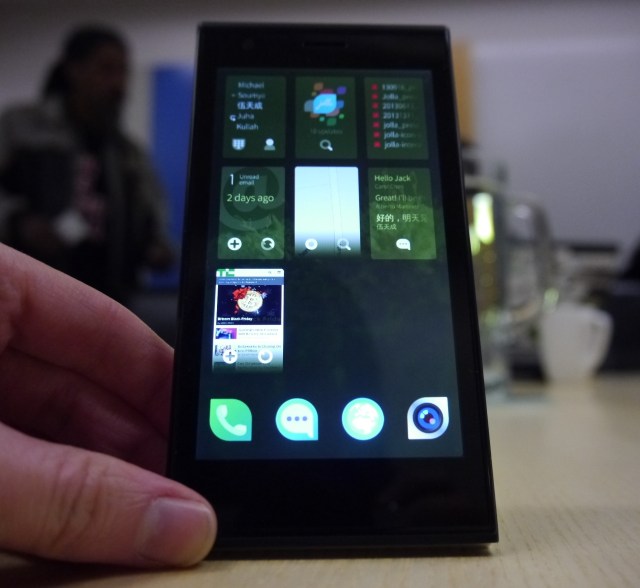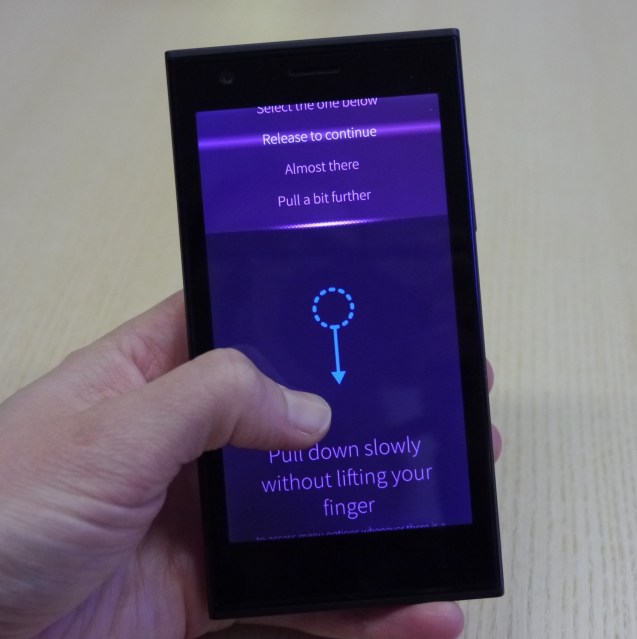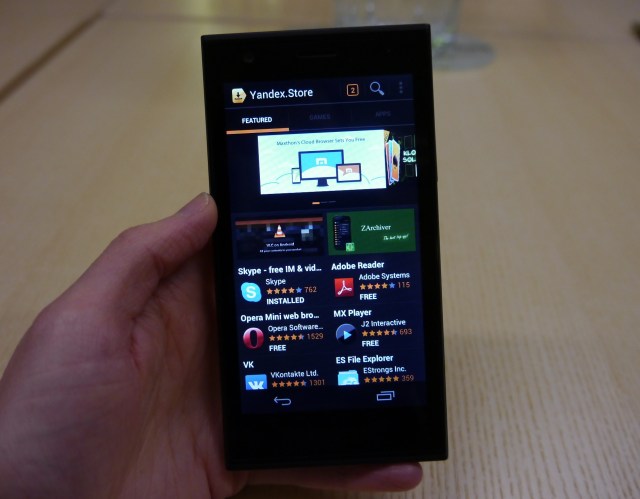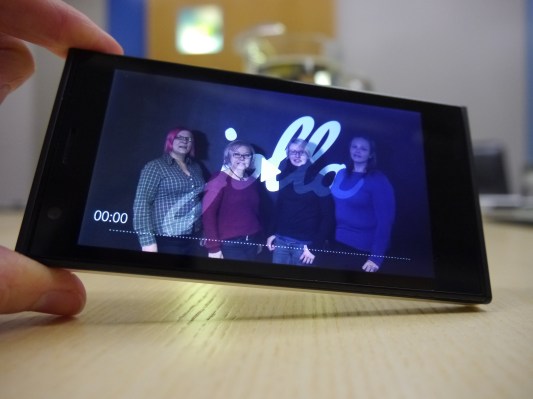The first handset from Finnish smartphone startup Jolla is simply called Jolla. This phone has been some two years in the making — a timeframe that testifies to the complexity of building handset hardware and a new mobile platform, not to mention rallying developers and achieving Android compatibility. So really two years ain’t bad for a plucky startup whose members used to work for erstwhile king-of-the-mobile-world, Nokia, and left to do what that phone maker decided it couldn’t: make a go of MeeGo as an alternative to Google’s all-consuming Android.
What was MeeGo on Nokia’s N9 is now Sailfish on Jolla’s eponymous handset. The Jolla phone finally launched on Wednesday, in Helsinki, with the first 450 devices taken home mainly by those who had already registered their interest via a pre-sales campaign. Jolla is now shipping handsets to other pre-orderers throughout Europe. The top three countries for pre-sales were, in order of popularity, Finland (as you’d expect), Germany and the U.K.
TechCrunch got hands-on with Jolla’s first phone for a few hours at a London press event, where two co-founders, Marc Dillon and Sami Pienimäki, were also on hand to answer questions.
[gallery ids="921150,921144,921149,921147,921142,921141,921151,921146,921143,921148,921140,921145"]
The Jolla phone hardware reforms the standard smartphone slab into an attractive plastic sandwich, as if two blocks of different coloured liquorice have been smacked together. The back piece — which was plain white on the above demo device but comes in bright pink for Finnish carrier DNA’s first batch of the phones, and in customisable colours in future when Jolla starts direct sales via its own website — is known as The Other Half.
Like Jolla’s software The Other Half is intended as an extensible platform — with connectors built into the back of the phone for power and a bus connection for data transfer allowing for Other Halves that could incorporate a physical Qwerty keyboard, for instance, or a weather station sensor or even an e-ink screen, as well as the NFC-powered software theme-swapping supported by the current crop of shells.
“Putting something like a keyboard is expected,” said Jolla co-founder Marc Dillon. “We are working on the developers kit so that anybody can do this… We’re working on accessories, and we expect third parties to work on accessories.”
The standard Jolla handset (i.e. with a not-too-fancy Other Half) is a nice size and weight in the hand — neither too big to be overbearing, nor too hefty or lightweight to feel unpleasant to hold. On paper, its specs come across as relatively mid-range — with a 4.5″ display, a dual-core chip, 4G, an 8MP camera plus 16GB of internal memory expandable via microSD card. But differentiating on phone hardware specs is not what Jolla is all about.
Its difference lies in the MeeGo-derived Sailfish software platform, and an open philosophy that wants developers — and other companies — to come in and build all sorts of software and hardware extensions atop this platform. The Jolla phone is a showcase for what Jolla the startup can do — tl;dr: see here what we built for ourselves, why not let us build something for you?
“You can’t really have an operating system without a spearhead device, and although we’ve been talking to almost everybody that’s in the mobile space over the last two years, almost every kind of manufacturer, I think they’ve all been waiting to see what we actually are capable of,” Dillon told TechCrunch.
“Because if you just look, people wise, then we’re really small compared to these guys. Their coffee budget is probably as much as we’ve spent to create this device!… So now they have a way to judge our capabilities by taking a real device and looking at it, and seeing what it does.”
Despite this b2b sales pitch, Jolla is committed to its own consumer play too — believing there is appetite for something new and different to shake up the samey-same smartphone space.
Dillon said about 80% of those who pre-ordered its handset earlier this year — in some instances without putting any down money down — have been converted into sales. Jolla hasn’t confirmed exactly how many devices were pre-ordered, saying only that it was a “typical” sized production batch — of up to 50,000 units. But it did take in €1 million’s worth of sales on the phone’s launch day, according to Dillon.
Doing a back-of-an-envelope calculation, by dividing that figure by the phone’s standard €399 price-tag, equates to 2,500 Jolla handsets sold in one day. Albeit, the pre-sales campaign muddies the water a little. Either way, generating €1 million in revenue in a day ain’t bad for a new kid on the phone block.
Indeed, getting a smartphone to market when you’re a startup of 80+ full-time employees, not an electronics behemoth like Apple or Samsung, is a monumental achievement in itself. But it is also just the start for Jolla. Now the even harder work of community building kicks off in earnest — if it’s to turn one phone into a whole new-wave open mobile movement.
Passion projects attract fans. And Jolla is clearly a passion project for Dillon, who tells me he personally shook the hand of everyone standing in line in Helsinki’s Narinkka Square for Wednesday’s Jolla launch. And for all the ex-Nokians who made the decision to leave to carry on developing a platform that Nokia was abandoning.
Jolla’s early buyers are also clearly passionate about the potential of (another) homegrown mobile platform. The question is whether Jolla can build a community beyond these nostalgic origins. Dillon argues it’s already doing that — and that the launch event was characterised by a broad spectrum of interest.
“There was everyone from high school students to retired people. There were men and women, different nationalities — there was of course a lot of Finns, being Finland, but there was also people had come in from some other countries,” he said.
“That was one of the things that we were actually curious about. Usually you have a set of early adopters for a new technology platform — we seem to break that. We had a very wide demographic who was taking our first device.”
I believe that people are looking for something different. Imagine if you could only buy two car choices in the world.
Why does he think Jolla is attracting diversity? “I think that the reason that people have had a lot of interest in us is there’s this David vs Goliath thing but also the fact that instead of just being a corporate face we’re coming out as people and we’re interested in people, and we are people, and I think there’s been a personal connection that we’ve made with a lot of people.
“And I believe that people are looking for something different. Imagine if you could only buy two car choices in the world. People can only buy what’s offered to them — and they’ve have had the same kind of experience for five years. So there’s a curiosity to see what happens next.”
But launches are by their nature exciting. The everyday reality of technology is that people crave the unexciting stuff too — functionality, reliability, stability, simplicity, (app) familiarity, and so on. Those are areas where Jolla has work to do. Its new mobile platform is inevitably an oxymoron: it’s both shiny and rough round the edges.
The Jolla UI is different to Android and iOS, excitingly so, to the point where you can feel its potential to offer something fluid, flexible and freeing to use. It also generally feels fast and responsive — although there is a small lag when opening or switching between apps, and progress bars pop up for certain actions which you might not expect, such as deleting a single photo.
But it’s inevitably still got a lot of kinks to iron out, including actual bugs that cause apps to crash or mess up, but also counterintuitive quirks — things not always working as you’d expect. One of the biggest challenges for Jolla is undoubtedly the learning curve its newness demands of users now fully embedded with icon-based, back-button-sign-posted mainstream user interfaces.
Navigating around Jolla’s UI requires a different set of gestures to iOS and Android; there’s no back button, there are very few buttons at all — it’s more push and pull, more like BlackBerry 10 or even Windows Phone, with gestures for peeking at content, and pulling in more stuff lurking off screen. (Of course Jolla would say its interface is Unlike all the rest.)
Other gestures close or minimise apps — the latter being displayed as small widgets on the homescreen which you can also interact with, if the developer has added in such functionality. So, for instance, you can refresh a webpage from the browser widget or command it open a new tab, or dive right in to search for an app on Jolla’s app store just by swiping left (or right) on the corresponding homescreen widget.

To navigate generally, the user has to follow subtle clues — such as a glowing bar that sometimes appears at the top or bottom of the screen or a menu, to signify there’s a list of actions that can be dragged on screen and selected within the same movement; or breadcrumbs of dots that appear at the top corner of the screen, which signify there are other screens’ worth of content waiting to be swiped into view.
Getting the hang of these elements is not the work of days, but it does take patience and a willingness to learn something new — something Jolla unfortunately can’t take for granted. Users also have to contend with Sailfish gestures being combined with Android nav elements (such as the Android back button and recent apps key) when running Android apps. Which dilutes Sailfish’s signposts with the very Android paradigms it’s hoping to supersede.
“We got rid of the home button — so we did eliminate one of them, but the back button, unfortunately, even though we have our own forward and back solution the [Android] applications still [use] so we still have to have those buttons,” said Dillon.
Jolla is working on getting a community portal rolled out to its website, which will include a forum where users can help each other out with queries — to supplement its already launched online care channel. It’s also making a series of how to videos to explain Sailfish navigation and gestures. And will be staffing a variety of social media contact points where people might be looking for answers, says Dillon. Plus there’s an on-device tutorial that walks users through the gesture basics.

All of this will certainly help, but getting people to switch from something they know to something different is by definition pushing water uphill — as Microsoft’s long hard slog to get Windows Phone to stick underlines.
Then of course there is the big challenge for any ‘other’ platform: the app gap that won’t go away. Even with Android compatibility — and Yandex’s app store preloaded — Jolla is inevitably starting a long way behind the Android-powered competition. In terms of native Sailfish apps (accessed via the Jolla store), there are but a handful at launch — I counted about 28 on the device, which includes basic stuff like an email client and a document viewer. There’s also no support for paid Sailfish apps, as yet, but that important developer incentive is coming down the line.
And then Yandex’s Android store presents only a smaller sub-set (apparently 85,000) of the apps Android users get on Google Play (one million+), so inevitably a lot of titles you’d find on bog standard Android are not on these shelves. (And while you may be able to sideload some Android apps, there’s no guarantee of smooth or even workable compatibility with Sailfish).

Even tapping directly into the Android apps on the preloaded Yandex Store isn’t a guarantee of smooth results as there are ongoing compatibility issues at this (early) point. Notably, the Android runtime sometimes spontaneously takes over the interface, dragging the user back to an Android app they had quit out of, as if Mountain View is wrestling back control from this open mobile upstart.
Compatibility issues also mean Android apps can appear buggy, with elements failing to correctly mesh with native Sailfish elements such as the keyboard, or degrading the experience so the app feels sluggish. On the other hand, other Android apps — such as Twitter — seemed to perform ok during my hands on so it’s not all bad. But it is inconsistent, and Jolla’s Dillon concedes the startup does have work to do on the Android compatibility front.
Regardless of myriad consumer-facing challenges, he says Jolla is in it for the long haul. It’s committed to providing its early adopters with a device that improves and continues to evolve, rather than hardware that withers on the vine (as Nokia’s N9 did). “The most important thing for us is that we continue to add value for everyone that bought this,” he said. “What features we do next, we believe the consumers should have a say in what the priorities are — and we will continue to deliver new features via the software.”
Jolla apparently has enough funding to sustain that effort too — with an alliance of industry backers committing to buoy up Sailfish to the tune of €200 million. Back in February Jolla itself also took in a €1 million investment from a Hong Kong based telecoms & mining firm, China Fortune, in exchange for 6.25% of the company. Chinese e-commerce giants Alibaba and Baidu have also been floated as future potential partners for Jolla — albeit that might just be wishful thinking at this point.
Jolla co-founder Sami Pienimäki said the company’s already spent about €20 million getting to the starting point of being able to release its first handset, running the Sailfish OS. How much more it may need to nurture and build out an ecosystem to really get Sailfish moving remains to be seen.
But why might other mobile makers want to use Jolla’s software to power their own devices? “Just using Sailfish is a differentiator already because we were able to take a fresh look and do something new,” said Dillon, when I pose this question. “We [also] have no competing services, or no required embedded services” — a veiled reference to how Google tries to keep its Android OEMs (and developers) in line, by dangling the carrot of access to its Play store.
Beyond ‘not being Android’, Dillon argues that Sailfish is a place where the next wave of mobile innovation can occur — a liberal space for experimentation, for forming a way beyond the status quo of segmented services and individual apps consumed in a cacophonous pick’n’mix. Somewhere where smarter, more unified and better targeted services can be developed.
This is just the beginning of how I believe mobile’s going to start to break this application barrier.
“What I think the platforms are going to do — and where a real differentiation is going to occur — is when services start to get integrated here [on the homescreen] and not just sticking your application and embedding it into the device but actually connecting multiple applications together to make a more seamless experience,” he told TechCrunch.
Instead of users harvesting data from multiple apps and places individually within a device, Dillon envisages a platform where more and more apps plug into each other to funnel data to where it’s needed rather than sitting in separate silos that the user is required to visit.
“I don’t want to deal with events the second that they happen all of the time, so when I look [at my Jolla phone] I see that there’s these phone calls that I’ve made, so there’s a constant reminder that these are the people in my life at the moment that I’m communicating with… The same with messages… or email… This is just the beginning of how I believe mobile’s going to start to break this application barrier,” he said.
“These kinds of synergies between things is just starting, so that you don’t have to cross apps all the time,” he added. “What we’re doing is we’re creating a place where these things — well beyond what I can think of or tell you today — are going to occur.
“The openness of the platform lets a developer, a company, an entrepreneur, a new business take something from the user experience all the way down to the hardware, the metal, the silicon — across to one or more Internet services, and provide something that is going to connect a user to one or more services that are locally relevant, that are important to you right now and not spammy.”
All that is for the uncertain future. For now, Jolla has shown a startup can make a smartphone. So it’s already proven a lot of its doubters wrong. It’s also positioned itself to take up the baton from Nokia, as THE Finnish mobile maker — just as Nokia prepares to give up that role (by selling its Devices & Services unit to Microsoft). Which is cruel or opportune timing, depending on your perspective.
Building a new smartphone on a new platform is already an impressive achievement. But Jolla isn’t about to stop and admire the view. This startup has no intention of letting a single lovingly crafted handset remain its crowning glory. Onward Sails!
